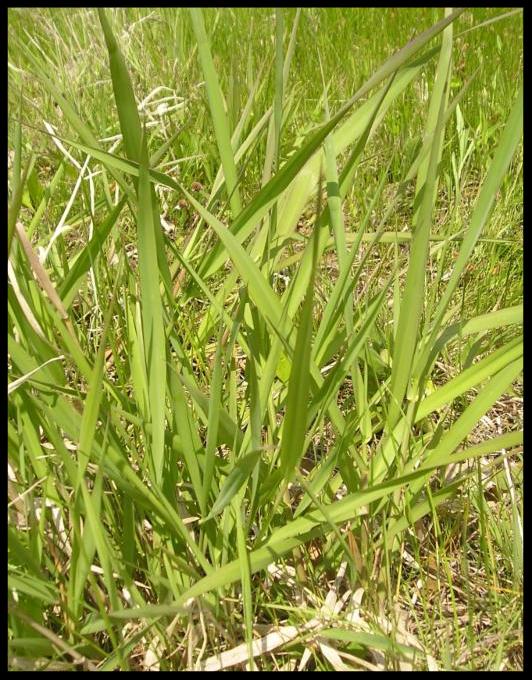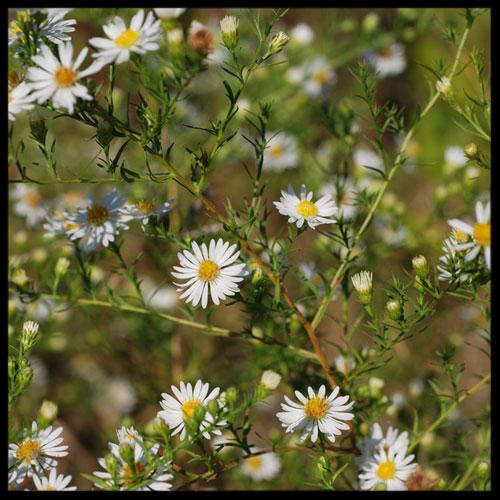|
September Article
|
Our Late Bloomers- Asters are Worth the Wait!
When we think about fall we often anticipate the cool, crisp mornings, kids getting back to school, football, and brilliant landscapes painted in red, orange, yellow, and every color in-between. Our vegetable gardens slowly shut down, leaves start dancing around our yards, and pumpkins mysteriously show up on steps overnight. Our shore and prairie areas that were once lush and green start to feel the effects of shorter days and cooler nights, slowly morphing into stands dominated by hues of stark yellow and brown. But if you look closely, in amongst the browning warm season grasses, are a group of forbs that buck the fall season trend and treat us with dazzling blooms of color. Our native aster species are quite amazing by being able to tolerate some pretty chilly evenings, and still produce striking flowers in shades of blue, purple, pink, and white.
 |
|
 |
Large Leaf Aster
|
In Minnesota, we have a
multitude of aster species that can
be found along shores, in prairies, and even in dense woods. For example, Large Leaf Aster (
Eurybia macrophylla syn. Aster macrophyllus
) grows wonderfully in shady places. New England Aster (
Symphyotrichum novae-angliae syn. Aster novae-angliae
) puts out brilliant shows of purple along wet shoreline areas. Right now, we often see many aster species blooming alongside roadsides or woodland edges.
|
|
 |
|
Smooth Blue Aster
|
 |
Sky Blue Aster (
Symphyotrichum oolentangiense syn. Aster azureus
) is a beautiful blue aster that likes sunny
spots. Have a dry prairie?
Aromatic Aster (
Symphyotrichum oblongifolium syn. Aster oblongifolius
) and Smooth Blue Aster (
Symphyotrichum laeve syn. Aster laevis
) both love dry and sandy or rocky soils and flourish in short grass prairie restorations. These species are also very drought tolerant; which certainly wasn't a problem for us this year.
There are many bees,
butterflies, wasps, and other insects that still are actively searching for food into the fall season. With the seasonal decline of the summer bloomers, it can be harder and harder for insects to find the necessary nectar and pollen in the fall. That is where the asters step in. Most of our asters typically bloom in September and October, making them critical sources of food for pollinators. Many of our asters can have dozens to hundreds of small flowers on each plant that provide both nectar and pollen
for insects.
|
|
 |
|
Heath Aster
|
 |
He
ath Aster
(
Symphyotrichum ericoides
Syn
. Aster erioides
)
is an example of an aster with bountiful flowers, enabling dozens of insects to
visit the plant at the same time. Some asters are host plants to various butterflies and moths as well, providing critical elements in their life cycles. If that wasn't enough, birds and small animals like turkeys, grouse, sparrows, and mice also eat the seeds of various aster species, making these plants highly valuable for wildlife food and habitat.
With leaves taking the center stage in the fall, it is really easy to forget about our asters. So next time you take a walk through the woods to gaze at the wonderful fall leaves, give your neck a break from looking up and search the ground for a few aster species. You will probably be surprised at what you find! Asters are really critical components in our Minnesota ecosystems and it's really fun to spend a few minutes to search for them this time of year.
There is still time to plant! Missing some asters in your restoration? The season isn't over yet! Contact our nursery manager Jill at
[email protected]
to place a plant order! Not sure what aster will work best for your restoration? Our experience nursery staff can answer any questions you have about our native plants and look forward to helping you choose the right ones.
|
Natural Shore Has Moved!
We have moved a mile from our Maple Plain location to a new office in neighboring Independence, MN. Our new location will allow us to better serve our clients' needs.
Our new retail nursery address is:
1480 County Rd 90. Independence MN 55359
Interested in Native Plants? Contact our Greenhouse Manager Jill at [email protected] |
|
Native Plant of the Month
|
Sky Blue Aster 
Symphyotrichum oolentangiense syn. Aster azureus
Moisture: Moist or Dry
Exposure: Sun or Partial Shade
Color: Light Blue
Blooms: August-October
Height: 2-3.5 Feet
Sky Blue Aster is an autumn bloomer with many pale blue flowers. The plant is rough to the touch (feels like sandpaper) due to short stiff hairs on the stem and leaves. Their basal leaves are stalked and heart-shaped with the middle and upper leaves more narrow and not heart-shaped. The flowers have specialized scale-like bracts beneath the flowers that are "diamond-tipped". Their flowers are oriented in clusters with arrangement with flowers opening at varying times. They are found in a wide range of habitats from dry or moist prairies, meadows, open woods, to rocky slopes. Sky Blue Aster is very drought tolerant and is a larval plant for some butterfly larvae and nectar plant for butterflies. Another common name is prairie heart-leaved and Azure Aster.
|
|
Invasive Plant of the Month
|
Reed Canary Grass 
Phalaris arundinacea
Exposure: Sun or Partial Shade
Moisture: Moist
Height: 2-5 Feet
Reed Canary Grass is a non-native grass that likes wet environments where it forms dense monocultures that reduce species diversity by choking out native plants. These dense stands have very little habitat value. Their roots form dense mats that go deep into the soil. This grass is light green with leaf blades about 10 inches long. They also have a papery sheath or ligule where the leaf meets the stem. This grass flowers in early summer with plumes that are 3-8 inches long that will mature into tight, tan heads.
Management strategies include preventing it from going to seed by regular mowings and timely herbicide treatments with

glyphosate. Fall is a great time to spray Reed Canary grass as it is starting to pull its resources into its root system in preparation for winter. Fall is also a good time to spray Reed Canary grass because native plants go dormant while this plant stays green longer, resulting in less collateral damage of native plants.
|
Viceroy

Limenitis archippus
Range
: Most of the continental US as well as parts of Mexico and Canada
Habitat
: Wet areas like lakesides, creekbeds, wet meadows, lower woodland areas, and roadsides.
Identification
: Viceroy butterflies look very similar to Monarch Butterflies with the orange background, black stripes, and white dots on their wings. However, Viceroy butterflies are smaller than Monarchs and have a black line on the upper side of their lower wings.
Pollination
: Viceroy butterflies feed on Aster species like Heath Aster, New England Aster, and others. They also feed on Goldenrod species, Joe Pye Weed, and other native plants species blooming in the later summer into the fall.
|
|
|
Our retail nursery is open f
or the 2016 season! Want to place a plant order? Contact Jill at [email protected]
Click and visit our website for current
|
Fall Color!
Still want beautiful colors in your garden through the fall? Check out these Asters that bloom into October! They also provide an important late season food source for pollinators!
1. Heath Aster
(
Symphyotrichum ericoides syn. Aster ericoides )

Moist/Dry, Sun/Partial Shade, White, 1-3 ft.
2. New England Aster (
Symphyotrichum novae-angliae syn. Aster novae-angliae)

Wet/Moist, Sun/Partial Shade, Purple, 3-5 ft.
3. Sky Blue Aster
(
Symphyotrichum oolentangiense syn. Aster azureus)

Moist/Dry, Sun/Partial Shade, Blue, 2-3.5 ft.
4. Smooth Blue Aster (Symphyotrichum laeve syn. Aster laevis)
Moist/Dry, Sun/Partial Shade, Blue, 1-3 ft.
5. Aromatic Aster
(Symphyotrichum oblongifolium syn. Aster oblongifolius)

Dry, Full Sun, Violet, 1-2 ft.
|
|
 |
|